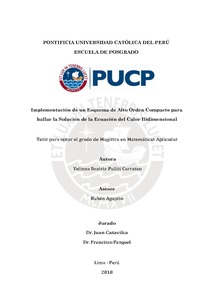| dc.contributor.advisor | Agapito Ruiz, Rubén Ángel | |
| dc.contributor.author | Pulliti Carrasco, Yelinna Beatriz | es_ES |
| dc.date.accessioned | 2018-09-06T20:33:28Z | es_ES |
| dc.date.available | 2018-09-06T20:33:28Z | es_ES |
| dc.date.created | 2018 | es_ES |
| dc.date.issued | 2018-09-06 | es_ES |
| dc.identifier.uri | http://hdl.handle.net/20.500.12404/12591 | |
| dc.description.abstract | En el presente trabajo, el cual está basado en [7] y [8], analizamos dos métodos para construir
esquemas de alto orden compactos para resolver la ecuación del calor bidimensional en un
dominio espacial rectangular. También explicamos paso a paso la construcción de un método
no eficiente y otro eficiente (desde el punto de vista computacional) para calcular esquemas de
alto orden compacto, partiendo desde los esquemas unidimensionales de alto orden hasta finalizar
con el algoritmo respectivo en pseudocódigo, esto con el objetivo de resolver problemas
de valor inicial y condiciones de frontera periódicas para la ecuación del calor bidimensional.
Finalmente estudiamos las condiciones generales de estabilidad para el caso de condiciones
de frontera no periódicas, cuyo análisis es omitido por [7] y [8].
Primeramente definimos h como el tamaño de paso para la discretización espacial, ¢t
como el tamaño de paso para la discretización temporal, y N como la cantidad de operaciones
que deben realizarse para hallar la solución numérica.
El primer método presentado se considera ineficiente, a diferencia del segundo método
que sí se considera eficiente, según el siguiente criterio:
Un esquema numérico se considera eficiente si cumple las tres siguientes condiciones: estabilidad,
orden de aproximación a la solución analítica mayor a O(h2), y complejidad computacional
inferior a O(N3) para el caso unidimensional.
Se prefieren los esquemas implícitos a los explícitos y asumir condiciones de frontera
periódicas, dada la dificultad para hallar esquemas de alto orden compacto estables que consideren
condiciones de frontera tanto periódicas como no periódicas. Finalmente por motivo
de la complejidad computacional al hallar la solución numérica, se prefieren algoritmos optimizados
en lugar de algoritmos iterativos con más de dos bucles anidados, ya que los métodos
de diferencias finitas en general implican operaciones entre vectores y matrices, lo que suele
incrementar la complejidad computacional de los algoritmos empleados en su implementación. | es_ES |
| dc.description.abstract | In the present work, that is based on [7] and [8], we analyze two methods to construct high
order compact schemes to solve the bidimentional heat equation in a rectangular domain. Also
we explain step by step the construction of a non efficient method and an eficient one (from the
computational point of view) for calculating high order compact schemes. We start with the
high order unidimensional schemes and end with the respective algorithm in pseudocode, this
is for solving initial value problems with periodic boundary conditions for the bidimensional
heat equation. Finally we study the general conditions for stability in the case of non periodic
boundary conditions. This analysis is omitted by [7] and [8].
First we define h as the spatial discretizing step size, ¢t as the time discretizing step size,
and N as the number of operations to make for finding the numerical solution.
The first shown method is considered inefficient, on the other hand the second one is
considered efficient according to the following criteria:
A numerical scheme is considered efficient if if satisfy these three conditions: stability,
accuracy order to the analytical solution superior to O(h2), and computational complexity
inferior to O(N3) for the unidimensional case.
Implicit schemes are prefered to explicit ones and asumming periodic boundary conditions,
because it is difficult to find stable high order compact schemes with periodic and non
periodic boundary conditions. Finally because of the computational complexity to find the
analytical solution, it is preferred optimized algorithms to iterative altorithms with more
than two nested loops. Finite difference methods imply vectorial and matricial operations,
and this often increments the computational complexity of the implemented algorithms. | es_ES |
| dc.description.uri | Tesis | es_ES |
| dc.language.iso | spa | es_ES |
| dc.publisher | Pontificia Universidad Católica del Perú | es_ES |
| dc.rights | info:eu-repo/semantics/openAccess | es_ES |
| dc.rights.uri | http://creativecommons.org/licenses/by-nc-nd/2.5/pe/ | * |
| dc.subject | Ecuaciones diferenciales | es_ES |
| dc.subject | Soluciones numéricas | es_ES |
| dc.title | Implementación de un esquema de alto orden compacto para hallar la solución de la ecuación del calor bidimensional | es_ES |
| dc.type | info:eu-repo/semantics/masterThesis | es_ES |
| thesis.degree.name | Magístra en Matemáticas Aplicadas | es_ES |
| thesis.degree.level | Maestría | es_ES |
| thesis.degree.grantor | Pontificia Universidad Católica del Perú. Escuela de Posgrado | es_ES |
| thesis.degree.discipline | Matemáticas Aplicadas | es_ES |
| renati.discipline | 541147 | es_ES |
| renati.level | https://purl.org/pe-repo/renati/level#maestro | es_ES |
| renati.type | http://purl.org/pe-repo/renati/type#tesis | es_ES |
| dc.publisher.country | PE | es_ES |
| dc.subject.ocde | https://purl.org/pe-repo/ocde/ford#1.01.02 | es_ES |






